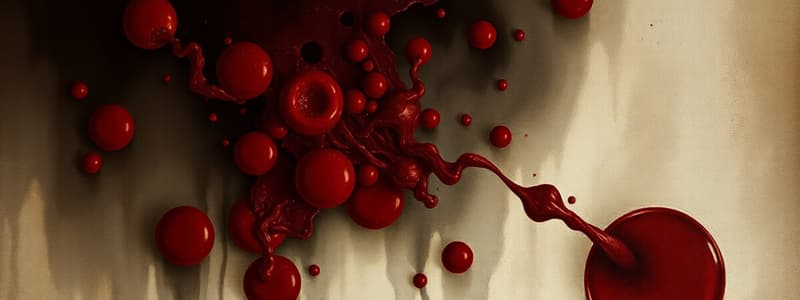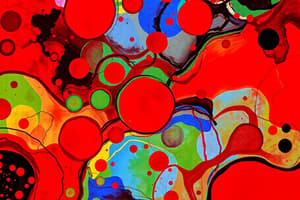Podcast
Questions and Answers
Which of the following is not a function of blood?
Which of the following is not a function of blood?
- Maintenance of body temperature
- Regulation of body pH
- Transport of oxygen
- Protection against foreign substances
- Production of bile (correct)
What is the normal pH range of blood?
What is the normal pH range of blood?
- 7.5-8.0
- 8.0-8.5
- 7.0-7.25
- 7.35-7.45 (correct)
- 6.5-7.0
How does blood maintain body temperature?
How does blood maintain body temperature?
- By shunting warm blood to the skin
- By absorbing heat from the environment
- By storing heat in red blood cells
- By shunting warm blood to the interior of the body (correct)
- By dissipating heat through platelet activity
Which component of blood provides protection against foreign substances?
Which component of blood provides protection against foreign substances?
What percentage of blood volume is plasma?
What percentage of blood volume is plasma?
What is the primary component of plasma?
What is the primary component of plasma?
Which plasma protein is involved in blood clotting?
Which plasma protein is involved in blood clotting?
What is the primary function of albumins in plasma?
What is the primary function of albumins in plasma?
Which type of plasma protein is involved in immunity?
Which type of plasma protein is involved in immunity?
Which type of blood cell lacks a nucleus?
Which type of blood cell lacks a nucleus?
What is the lifespan of red blood cells?
What is the lifespan of red blood cells?
What is the primary function of red blood cells?
What is the primary function of red blood cells?
What are the two main types of white blood cells?
What are the two main types of white blood cells?
Which type of white blood cell is the most abundant?
Which type of white blood cell is the most abundant?
Platelets are fragments of which type of cell?
Platelets are fragments of which type of cell?
What element is essential for oxygen binding in hemoglobin?
What element is essential for oxygen binding in hemoglobin?
Which type of hemoglobin is bound to oxygen?
Which type of hemoglobin is bound to oxygen?
What enzyme in red blood cells facilitates the conversion of CO2 and H2O into bicarbonate?
What enzyme in red blood cells facilitates the conversion of CO2 and H2O into bicarbonate?
All formed elements in the blood are derived from...
All formed elements in the blood are derived from...
Which precursor cell gives rise to red blood cells?
Which precursor cell gives rise to red blood cells?
What hormone stimulates red blood cell production?
What hormone stimulates red blood cell production?
Which white blood cell is primarily responsible for fighting bacterial infections?
Which white blood cell is primarily responsible for fighting bacterial infections?
Which white blood cell becomes a macrophage in tissues?
Which white blood cell becomes a macrophage in tissues?
Lymphocytes are divided into which two main types?
Lymphocytes are divided into which two main types?
What is the first step in hemostasis?
What is the first step in hemostasis?
What protein forms the meshwork in blood clots?
What protein forms the meshwork in blood clots?
What is the function of platelets during hemostasis?
What is the function of platelets during hemostasis?
What happens to red blood cells after 120 days in circulation?
What happens to red blood cells after 120 days in circulation?
What is the fate of the globin portion of hemoglobin?
What is the fate of the globin portion of hemoglobin?
The heme portion of hemoglobin is broken down into...
The heme portion of hemoglobin is broken down into...
Which substance is a breakdown product of heme that is excreted in bile?
Which substance is a breakdown product of heme that is excreted in bile?
What percentage of oxygen is transported bound to hemoglobin?
What percentage of oxygen is transported bound to hemoglobin?
Most carbon dioxide is transported in the blood as...
Most carbon dioxide is transported in the blood as...
What enzyme catalyzes the reaction between carbon dioxide and water to form bicarbonate?
What enzyme catalyzes the reaction between carbon dioxide and water to form bicarbonate?
Which granulocyte is involved in allergic reactions?
Which granulocyte is involved in allergic reactions?
Which white blood cell increases in number during parasitic infections?
Which white blood cell increases in number during parasitic infections?
What is the role of thrombin in the coagulation process?
What is the role of thrombin in the coagulation process?
What is the final step in the clotting process?
What is the final step in the clotting process?
Platelet plugs form by platelets adhering to...
Platelet plugs form by platelets adhering to...
A decrease in red blood cell count or hemoglobin is called...
A decrease in red blood cell count or hemoglobin is called...
Flashcards
Blood function - NOT bile production
Blood function - NOT bile production
Blood doesn't produce bile; it transports oxygen, regulates pH, maintains temperature, and protects against foreign invaders.
Normal blood pH range
Normal blood pH range
The healthy blood pH range is 7.35-7.45.
Blood temperature regulation
Blood temperature regulation
Blood maintains body temperature by distributing warm blood to the body's core.
Blood foreign substance defense
Blood foreign substance defense
Signup and view all the flashcards
Plasma percentage in blood
Plasma percentage in blood
Signup and view all the flashcards
Plasma main component
Plasma main component
Signup and view all the flashcards
Blood clotting plasma protein
Blood clotting plasma protein
Signup and view all the flashcards
Albumin's plasma function
Albumin's plasma function
Signup and view all the flashcards
Plasma immunity protein
Plasma immunity protein
Signup and view all the flashcards
Nucleus-lacking blood cell
Nucleus-lacking blood cell
Signup and view all the flashcards
Red blood cell lifespan
Red blood cell lifespan
Signup and view all the flashcards
RBC primary function
RBC primary function
Signup and view all the flashcards
White blood cell types
White blood cell types
Signup and view all the flashcards
Most abundant WBC
Most abundant WBC
Signup and view all the flashcards
Platelet cell origin
Platelet cell origin
Signup and view all the flashcards
Hemoglobin oxygen binding element
Hemoglobin oxygen binding element
Signup and view all the flashcards
Oxygen-bound hemoglobin form
Oxygen-bound hemoglobin form
Signup and view all the flashcards
CO2 to bicarbonate conversion enzyme
CO2 to bicarbonate conversion enzyme
Signup and view all the flashcards
Blood formed element origin
Blood formed element origin
Signup and view all the flashcards
RBC precursor cell
RBC precursor cell
Signup and view all the flashcards
RBC production stimulator
RBC production stimulator
Signup and view all the flashcards
Bacterial infection fighter WBC
Bacterial infection fighter WBC
Signup and view all the flashcards
Tissue macrophage origin WBC
Tissue macrophage origin WBC
Signup and view all the flashcards
Lymphocyte types
Lymphocyte types
Signup and view all the flashcards
First hemostasis step
First hemostasis step
Signup and view all the flashcards
Blood clot mesh protein
Blood clot mesh protein
Signup and view all the flashcards
Platelet hemostasis role
Platelet hemostasis role
Signup and view all the flashcards
RBC fate after 120 days
RBC fate after 120 days
Signup and view all the flashcards
Globin breakdown products
Globin breakdown products
Signup and view all the flashcards
Heme breakdown products
Heme breakdown products
Signup and view all the flashcards
Bile excretion substance
Bile excretion substance
Signup and view all the flashcards
Oxygen transport percentage
Oxygen transport percentage
Signup and view all the flashcards
CO2 transport in blood
CO2 transport in blood
Signup and view all the flashcards
Bicarbonate enzyme
Bicarbonate enzyme
Signup and view all the flashcards
Allergies-related granulocyte
Allergies-related granulocyte
Signup and view all the flashcards
Parasitic infection WBC
Parasitic infection WBC
Signup and view all the flashcards
Thrombin's clotting role
Thrombin's clotting role
Signup and view all the flashcards
Final clotting step
Final clotting step
Signup and view all the flashcards
Platelet adhesion site
Platelet adhesion site
Signup and view all the flashcards
Low RBC count/hemoglobin
Low RBC count/hemoglobin
Signup and view all the flashcards
Study Notes
Section 1: Functions of Blood
-
Blood transports oxygen
-
Blood regulates pH
-
Blood maintains body temperature
-
Blood protects against foreign substances.
-
Blood does not produce bile
-
Normal blood pH range: 7.35-7.45
-
Blood maintains body temperature by regulating the flow of warm blood, shunting it to the interior or skin.
-
White blood cells protect against foreign substances
Section 2: Composition of Blood
-
Plasma accounts for 55% of blood volume
-
The primary component of plasma is proteins.
Section 3: Formed Elements
-
Erythrocytes (red blood cells) lack a nucleus.
-
Lifespan of red blood cells: 90-120 days
-
Red blood cells transport oxygen and carbon dioxide.
-
White blood cells are categorized into granulocytes and agranulocytes
- Granulocytes include neutrophils, eosinophils, and basophils.
- Agranulocytes include lymphocytes and monocytes.
-
Neutrophils are the most abundant type of white blood cell.
-
Platelets are fragments of megakaryocytes.
Section 4: Hemoglobin and Gas Transport
-
Iron is essential for oxygen binding in hemoglobin.
-
Oxyhemoglobin is the form of hemoglobin bound to oxygen.
-
Carbonic anhydrase converts carbon dioxide and water into bicarbonate in red blood cells.
Section 5: Hematopoiesis
-
All formed elements in the blood are derived from hematopoietic stem cells.
-
Proerythroblasts give rise to red blood cells.
-
Erythropoietin stimulates red blood cell production.
Section 6: White Blood Cells and Immunity
-
Neutrophils are primarily responsible for fighting bacterial infections.
-
Monocytes become macrophages in tissues.
-
Lymphocytes are divided into B cells and T cells.
-
Eosinophils increase in number during parasitic infections.
Section 7: Hemostasis
-
Vascular spasm is the first step in hemostasis.
-
Fibrin forms the meshwork in blood clots.
-
Platelets form platelet plugs during hemostasis.
Section 8: Hemoglobin Breakdown
- Red blood cells are broken down by macrophages in the spleen after 120 days in circulation.
- Globin (part of hemoglobin) is broken down into amino acids.
- Bilirubin is a breakdown product of heme, excreted in bile.
Section 9: Gas Transport
- Approximately 98.5% of oxygen is transported bound to hemoglobin.
Section 10: White Blood Cells
- Basophils are involved in allergic reactions.
Section 11: Hemostasis (continued)
- Thrombin breaks down fibrinogen into fibrin in the clotting process.
Section 12: Blood Disorders
- Anemia is a decrease in red blood cell count or hemoglobin.
Studying That Suits You
Use AI to generate personalized quizzes and flashcards to suit your learning preferences.




